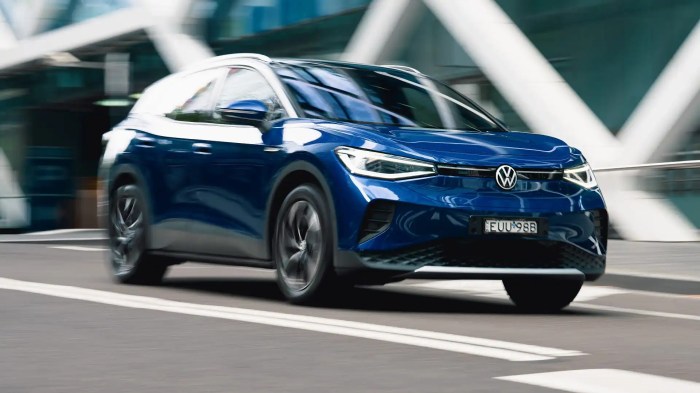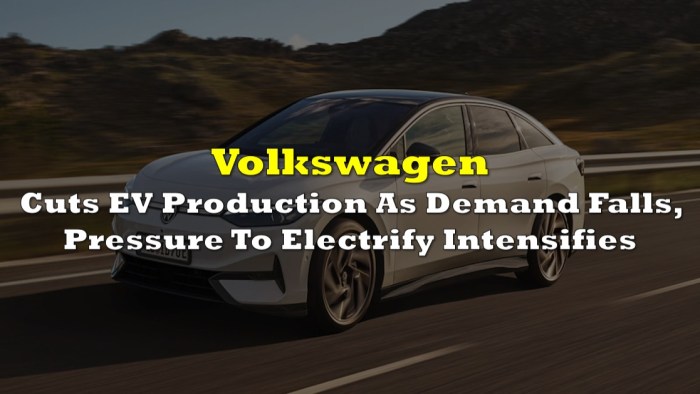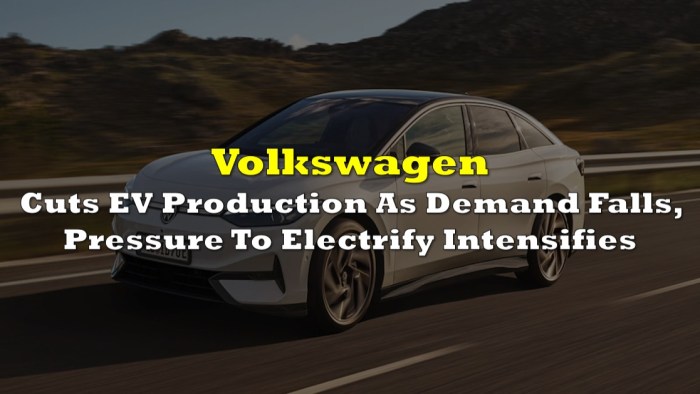Volkswagen cuts EV production demand shrinking: a stark reality that signals a shift in the electric vehicle landscape. The German automotive giant, once a leader in the EV race, has been forced to adjust its ambitious production plans due to a slowdown in demand.
This decision, while surprising to some, reflects the complex interplay of global economic conditions, consumer preferences, and the evolving market dynamics within the EV sector.
The shrinking demand for EVs is a multifaceted issue. Rising inflation, global economic uncertainty, and increasing energy costs have all contributed to a decline in consumer appetite for electric vehicles. Moreover, concerns regarding battery range, charging infrastructure, and the overall cost of ownership continue to weigh on consumer decisions.
Volkswagen’s EV Production Cuts
Volkswagen, a leading automotive manufacturer, has recently announced production cuts for several of its electric vehicle (EV) models. This decision has sparked widespread interest and speculation about the future of Volkswagen’s EV strategy.
Reasons Behind the Production Cuts
Volkswagen’s decision to cut EV production stems from a confluence of factors, including a challenging global economic environment, supply chain disruptions, and changing consumer demand. The company has cited a slowdown in the demand for EVs, particularly in Europe, as a key reason for the cuts.
EV Models Affected by Production Cuts
The production cuts primarily affect Volkswagen’s ID.3 and ID.4 models, which are two of the company’s flagship EVs. The ID.3 is a compact hatchback, while the ID.4 is a mid-size SUV. Both models have been crucial to Volkswagen’s EV strategy, and the production cuts are a significant setback for the company.
Impact on Volkswagen’s Overall EV Strategy
The production cuts are a significant setback for Volkswagen’s ambitious EV goals. The company has pledged to become a leading player in the global EV market, and these cuts raise questions about its ability to meet these targets.
Timeline of Volkswagen’s EV Production Plans
Volkswagen’s EV production plans have undergone several changes in recent years. Initially, the company aimed to produce over 1 million EVs by 2025. However, this target has been revised downwards due to the challenges mentioned above.
Shrinking Demand for EVs
The recent announcement of production cuts by Volkswagen, a leading player in the electric vehicle (EV) market, highlights a concerning trend: shrinking demand for EVs. While the EV market has experienced significant growth in recent years, several factors are now contributing to a slowdown in sales.
Understanding these factors is crucial for assessing the future trajectory of the EV market and its impact on the global automotive industry.
Global Economic Conditions, Volkswagen cuts ev production demand shrinking
The global economic landscape is a significant factor influencing EV sales. Rising inflation, interest rate hikes, and geopolitical tensions are creating economic uncertainty and impacting consumer spending. These factors are making it more challenging for consumers to justify the higher upfront cost of EVs compared to traditional gasoline-powered vehicles.
- For example, in the United States, the average price of a new EV is significantly higher than that of a gasoline-powered vehicle, making it a less attractive option for budget-conscious consumers.
- Furthermore, the rising cost of living is pushing consumers to prioritize essential expenses, such as food and housing, over discretionary purchases like new vehicles.
Consumer Sentiment and Preferences
Consumer sentiment and preferences are also playing a crucial role in the shrinking demand for EVs.
- While the environmental benefits of EVs are widely recognized, concerns about range anxiety, charging infrastructure limitations, and the availability of affordable models remain.
- In addition, the increasing popularity of hybrid vehicles, which offer a balance between fuel efficiency and affordability, is further impacting EV sales.
Comparison with Past Projections
The current demand for EVs falls short of projections made in the past. Many industry experts predicted that EV sales would accelerate rapidly, driven by government incentives, technological advancements, and growing consumer awareness. However, the reality is that the transition to EVs is taking longer than anticipated.
- For example, in 2020, several automotive manufacturers set ambitious targets for EV production and sales, but these targets have been revised downwards in recent years due to the challenges mentioned above.
- This discrepancy between projected and actual EV sales highlights the need for a more nuanced understanding of the factors driving consumer demand.
Volkswagen’s Response to Market Conditions

Volkswagen, like many other automakers, is facing the challenge of declining EV demand. The company is taking a proactive approach to adjust its strategy and navigate these market conditions.
Cost-Cutting Measures
To mitigate the impact of shrinking demand, Volkswagen is implementing a range of cost-cutting measures. These include:
- Production Adjustments:Volkswagen has already announced production cuts for certain EV models, such as the ID.4 and ID.5, in response to lower-than-expected sales. This aims to reduce inventory and optimize production capacity.
- Supply Chain Optimization:The company is streamlining its supply chain to reduce costs and improve efficiency. This involves renegotiating contracts with suppliers and exploring alternative sourcing options.
- Personnel Reductions:In some cases, Volkswagen has announced job cuts, particularly in areas where production has been scaled back. This is a difficult but necessary step to align its workforce with demand.
Impact on Long-Term EV Goals
While these adjustments may seem like a setback for Volkswagen’s long-term EV goals, the company remains committed to its electrification strategy. The cost-cutting measures are intended to ensure the sustainability and profitability of its EV business. Volkswagen believes that these adjustments will allow it to weather the current market challenges and emerge stronger in the long run.
Recent Statements from Volkswagen
In recent statements, Volkswagen CEO Oliver Blume has emphasized the company’s continued commitment to EVs, but also acknowledged the need for adjustments in light of market realities. Blume has stated that Volkswagen will remain focused on developing innovative and competitive EVs, while also prioritizing efficiency and cost control.
“We are adapting our strategy to the current market situation. This means being flexible and making necessary adjustments to ensure the success of our EV portfolio.”
Oliver Blume, CEO of Volkswagen
Check startup uses hi fi speakers develop eco friendly acoustic heat pumps to inspect complete evaluations and testimonials from users.
Industry Impact and Future Outlook: Volkswagen Cuts Ev Production Demand Shrinking

Volkswagen’s decision to cut EV production reflects a broader trend in the automotive industry. While the EV market is still in its nascent stages, the initial enthusiasm and rapid growth have been tempered by several factors, including rising inflation, supply chain constraints, and consumer concerns about range and charging infrastructure.
Impact on Other EV Manufacturers
Volkswagen’s move is likely to have a ripple effect on other major EV manufacturers. The industry is highly competitive, and any slowdown in demand or production can quickly impact other players. For example, Tesla, the current leader in the EV market, has already experienced a decline in demand and has had to adjust its production plans.
Similarly, other manufacturers like General Motors, Ford, and Hyundai may also face challenges in maintaining their EV production targets.
Future of the EV Market
The future of the EV market is uncertain, but several factors will shape its trajectory.
- Government Policies:Government incentives and regulations play a crucial role in driving EV adoption. The recent Inflation Reduction Act in the United States, for instance, offers significant tax credits for EV purchases, which could boost demand. However, the availability and effectiveness of such policies will vary across regions.
- Charging Infrastructure:The lack of adequate charging infrastructure remains a significant barrier to widespread EV adoption. Investing in robust charging networks, particularly in rural areas, is essential for increasing consumer confidence and driving EV sales.
- Battery Technology:Advances in battery technology, including improved range, faster charging times, and lower costs, are critical for making EVs more appealing to consumers. Continued innovation in this area will be crucial for the long-term success of the EV market.
- Consumer Preferences:Ultimately, the success of the EV market depends on consumer demand. Factors such as affordability, performance, and reliability will all influence purchasing decisions.
EV Production Plans Comparison
| Manufacturer | Production Target (2023) | Comments |
|---|---|---|
| Volkswagen | Reduced from 1.5 million to 1 million | Adjusting production due to market conditions |
| Tesla | 1.8 million | Aims to maintain its leadership position |
| General Motors | 400,000 | Investing heavily in EV production |
| Ford | 600,000 | Scaling up EV production significantly |
| Hyundai | 500,000 | Expanding its EV portfolio and production capacity |
Alternative Perspectives
While the current slump in EV demand is undeniable, it’s crucial to explore alternative viewpoints and consider the broader context. The decline might not solely be attributed to factors like rising prices and economic uncertainty.
Potential Long-Term Implications of the Current Market Conditions
The current market conditions could have significant long-term implications for the EV industry. While the immediate focus might be on addressing the shrinking demand, it’s important to consider the potential impact on future EV adoption and the overall transition to a more sustainable transportation system.
- Slower Adoption Rate:The current slowdown could lead to a slower-than-anticipated adoption rate of EVs, potentially delaying the widespread transition to electric vehicles. This could have implications for achieving climate goals and reducing reliance on fossil fuels.
- Increased Investment Risk:The shrinking demand might deter investors from pouring resources into the EV sector, leading to slower innovation and development of new technologies. This could hamper the long-term growth of the industry and its ability to compete with traditional car manufacturers.
- Impact on Infrastructure Development:The decline in EV sales could impact the development of charging infrastructure, potentially hindering the adoption of EVs in the future. This could create a chicken-and-egg scenario where a lack of charging infrastructure discourages EV purchases, further slowing down adoption.
Potential for a Resurgence in EV Demand
Despite the current challenges, there is still significant potential for a resurgence in EV demand in the future. This will likely depend on factors like government policies, technological advancements, and consumer sentiment.
- Government Incentives:Continued government support through tax credits, subsidies, and other incentives could play a crucial role in boosting EV demand. Governments worldwide are increasingly implementing policies to encourage the adoption of EVs, and these initiatives could prove vital in driving future growth.
- Technological Advancements:Continued improvements in battery technology, leading to longer ranges, faster charging times, and lower costs, could significantly increase the appeal of EVs. Advancements in autonomous driving technology could also contribute to a resurgence in demand, as consumers become more comfortable with self-driving vehicles.
- Changing Consumer Preferences:As consumers become more aware of the environmental benefits of EVs and experience the cost savings associated with electric vehicles, demand could rebound. Factors like rising fuel prices and concerns about climate change could further incentivize the shift towards electric vehicles.
Potential Solutions for Overcoming the Current Challenges
Several potential solutions can be implemented to address the current challenges and stimulate EV demand. These solutions focus on addressing consumer concerns, improving affordability, and fostering innovation within the industry.
- Price Reduction:Manufacturers could focus on reducing the cost of EVs, making them more accessible to a wider range of consumers. This could involve optimizing production processes, exploring alternative battery technologies, and leveraging economies of scale.
- Improved Charging Infrastructure:Expanding the availability of charging stations, particularly in rural areas and along major highways, would alleviate range anxiety and make EVs more convenient for long-distance travel. This would require collaboration between governments, private companies, and utilities.
- Enhanced Consumer Education:Educating consumers about the benefits of EVs, including their environmental impact, cost savings, and technological advancements, could help address misconceptions and encourage adoption. This could involve public awareness campaigns, online resources, and partnerships with influencers.





